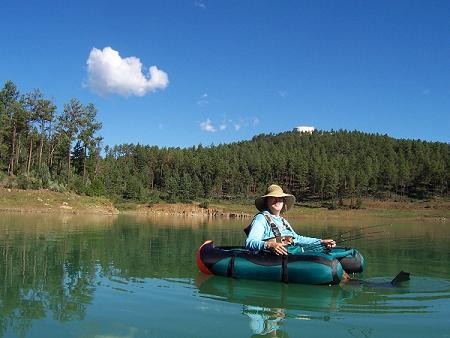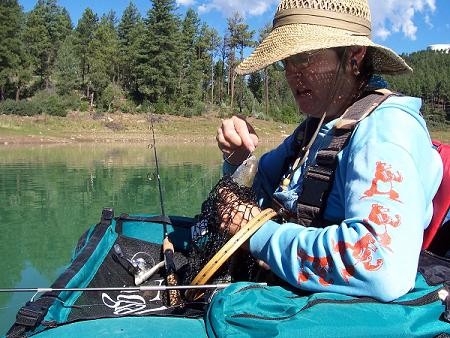
 |
 |
 |
 |
 |
| Home Page | Featured Articles | Awards | Photo Gallery | About Yvonne |
The stillness of the morning was broken only by an occasional splash on the surface of the water as a rainbow trout snatched a low flying insect for breakfast. Then a squirrel chattered in a tall pine tree on the lake’s shore. Lulled by the solitude, the angler gazed up at wispy clouds and followed a blue heron’s flight into the trees.
Suddenly her fishing pole jerked. Instantly alert, the angler flipped the pole up and set the hook, smiled and began gently reeling in her catch.
* * * * *
Early autumn in the mountains is perfect for fishing. Summer crowds have thinned, and trout prowl deep in cool waters.
* * *We’re casting for trout with Jane Terrel, a fisherman since childhood. “I’ve been fishing Grindstone ever since it opened,” she confided. “We’re lucky to have this beautiful lake so close by.”

Unlike others out today, Jane does not fish from a folding chair on the bank. Instead, she’s paddling across the lake’s surface in a float tube. Protected by chest-high neoprene waders and propelled by laced-on fins, Jane leads us to her favorite spot.
Bank-side fishermen follow our progress with wistful expressions.
After a half hour of finning (“Who says fishing isn’t an aerobic exercise?”), we arrive at a secluded cove.
“Not many people fish here because it’s hard to get to from shore. But look and listen--it’s quiet. There are blue herons, ospreys, turkey vultures, kingfishers, Muscovy and mallard ducks, killdeer, squirrels for company--a whole different experience.”
She unzips one of the pockets on the float tube and reaches for a small jar of bait. “Usually I prefer to fly fish, but I have been humbled this summer and have not gotten a single fish to hit a fly. We’ll try salmon eggs today.”
She attaches two bright red balls the size of English peas to the crooks of each of two hooks, one at the end of the four-pound test filament line, the second about a foot above it then hands the ultra light pole over.
“We match the gear to the size of the average catch. This makes our experience even more fun. If you hook into a really big one, the battle is on to keep it!!
“Hold the pole in one hand with your first two fingers above the reel. This gives you better balance and makes it easier to release the bail that holds the line. Unlock the bail, hold the rod up over your head, tip it back, and swing it forward. Don't forget to release the string as you swing the rod forward, and point at where you want the bait to go.”
You follow her directions and the lightly weighted line swings a graceful arc over the water and splashes in. “Take out the slack with the reel, hold the pole in your lap, and tip down. Now, when you feel a tug on the line, you’re in position to set the hook by jerking the tip up sharply. That keeps the fish on your line.”
She baits her own hook, casts and the two of you settle in for a quiet wait. Suspended in your tubes, you face the shore rather than across the lake and other fishermen. “Feels like your own private lake, doesn’t it.”
A blue kingfisher swoops down and snatches something from the surface of the water. A mama Muscovy duck and three ducklings glide by.
The famous seventeenth-century fisherman IzaakWalton could have pictured this scene when he wrote The Compleat Angler, a paean to the joys of fishing.
Suddenly there’s a tug on your pole and the tip noses down.
Jane reacts instantly. “You’ve got something! Now set the hook.” You obey, amazed that you got a strike so quickly.
“OK, now reel him in slowly, and don't let the line go slack, because we are fishing with barb-less hooks and the fish will spit it out if you give him much slack. Let him swim around and get tired, then reel him in a bit more.”
You and the fish play the line in and out, like a duet. Jane watches the pole bend even deeper. “He’s a good-sized one.”
A streak of silver flashes two feet from the surface. It’s a rainbow trout!
“OK, just keep him there.” Jane reaches out with a net and scoops up—your first fish!
“About ten inches, not bad.”

She holds the trout with one hand, reaches for her forceps and works out the size 14 barb-less hook. “I know it hurts, but it won’t take long,” she croons to the wriggling fish.
“If the fish has swallowed the hook too deep to release it without injury, I’ll clip the line and release the fish with the hook intact. The hook will dissolve in several days and the fish will get to live to bite another day.”
She holds the fish long enough for a picture, then, cradling him in her hands, lowers him into the water. “I’m looking for blood coming from his gills which would indicate the hook punctured something vital and he wouldn’t survive.”
The fish remains upright, no blood visible. In a few minutes, the fish escapes her hands and swims rapidly to the bottom. “He’s not badly traumatized. Let’s watch for a few minutes and make sure he’s all right.”
When no fish appears belly-up on the surface, Jane says, “He’s fine. Let’s re-bait the hook.”
No sooner does your line hit the water again when Jane’s pole bends down sharply. She sets the hook and begins the gentle tug of war.
“Some people like to reel fish in as fast as they can, but I like to take my time, to feel what’s going on.” The line moves back and forth. “He’s a fighter.”
When the trout breaks the surface, Jane nets him, removes the hook and again cradles the fish in the water. But this fish, unlike the first one, does not remain upright. Instead, it rolls over and Jane sees blood from its gills. “You’re dinner, fella.” She places the fish in the live well, a water-filled storage area in the tube.
The rest of the morning passes with several more strikes, most of which go back in the lake “to get big and strong for another fight.” But there are three nice pan-sized fish in the live well when clouds begin building in the west and you fin back to shore.
Jane eyes the day’s catch. “We’ll grill these tonight. I guarantee you’ve never tasted anything like freshly caught trout.” (See Sidebar: Jane’s Tasty Trout)
And it will taste extra special because you caught it—your first fish!
Trout are a versatile fish that can be fried, baked, grilled or poached. Jane’s favorite recipe is simple, fast and tasty.
TROUT EN PAPILLOTE
Clean and dress trout, leaving whole. Squeeze lemon juice inside and out. Season inside and out with Nature’s Seasonings ™. In the cavity, lay thin slices of lemon, onion and yellow squash.
Cut a sheet of waxed paper twice as long as the fish and lay one fish on it. Fold the paper over, forming a tent-like packet. Repeat for each fish.
To grill, wrap each wax paper packet in a square of aluminum foil and fold again into a packet. Put packets on grill. Grilling times vary according to size of fish and individual grill, but Jane suggests 4 minutes per side on medium-high heat as a guideline for ten-inch fish. To test for doneness, carefully unwrap hot packet (“Don’t burn your fingers!”) and flake with fork. When fish flakes easily, it is done.
To microwave, skip the aluminum foil and lay the waxed paper packets in a dish in the microwave. Microwaves also vary in power, so as a guideline, begin with a total of four minutes at High Power, do not turn over, and test for doneness by flaking.
Jane serves her Trout en Papillote with wild rice, smothered squash, spinach salad with vinaigrette and a Pouilly Fuisse white wine. Finish with a fruit sorbet. Bon apetit!
c. Alamogordo (NM) Daily News 2005
